Health Promotion through Website Development for Aboriginal Women with Diabetes
VerifiedAdded on 2023/06/11
|13
|3475
|427
AI Summary
This project aims to develop a website on diabetes management for Aboriginal women. The website will explore health promotional strategies in the management of Diabetes among the Aboriginal women. The promotion campaign and the development of a website are in line with the Ottawa Chatter on health promotion.
Contribute Materials
Your contribution can guide someone’s learning journey. Share your
documents today.
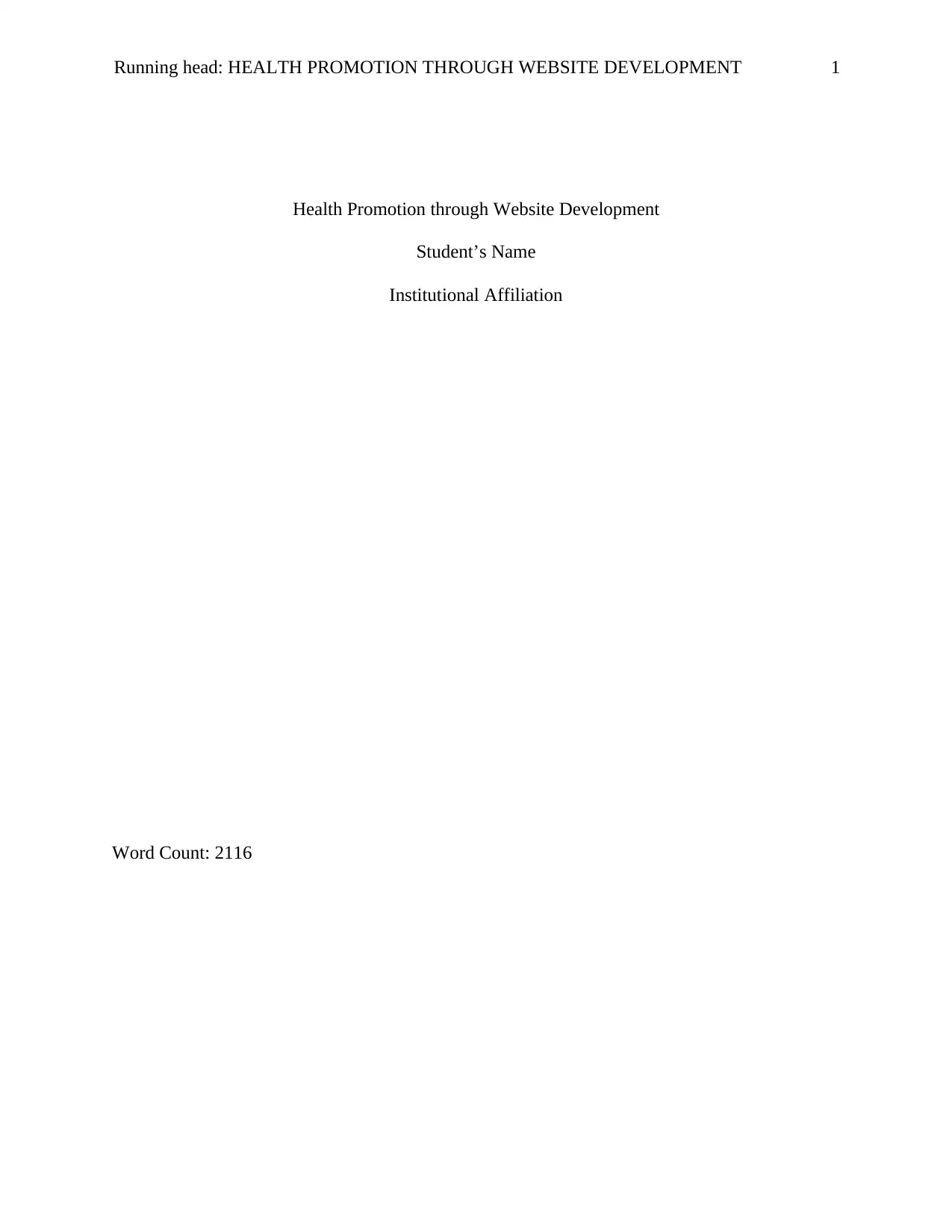
Running head: HEALTH PROMOTION THROUGH WEBSITE DEVELOPMENT 1
Health Promotion through Website Development
Student’s Name
Institutional Affiliation
Word Count: 2116
Health Promotion through Website Development
Student’s Name
Institutional Affiliation
Word Count: 2116
Secure Best Marks with AI Grader
Need help grading? Try our AI Grader for instant feedback on your assignments.
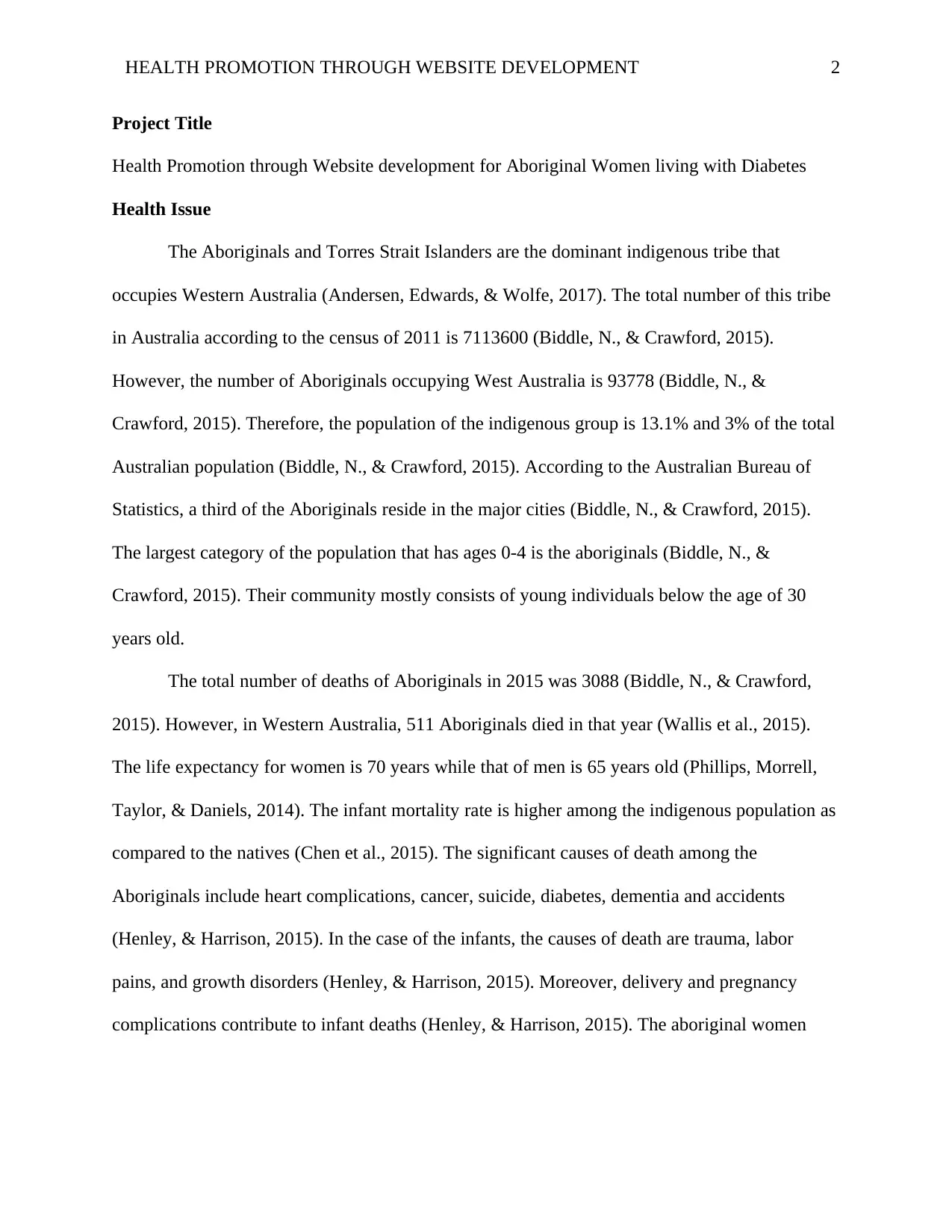
HEALTH PROMOTION THROUGH WEBSITE DEVELOPMENT 2
Project Title
Health Promotion through Website development for Aboriginal Women living with Diabetes
Health Issue
The Aboriginals and Torres Strait Islanders are the dominant indigenous tribe that
occupies Western Australia (Andersen, Edwards, & Wolfe, 2017). The total number of this tribe
in Australia according to the census of 2011 is 7113600 (Biddle, N., & Crawford, 2015).
However, the number of Aboriginals occupying West Australia is 93778 (Biddle, N., &
Crawford, 2015). Therefore, the population of the indigenous group is 13.1% and 3% of the total
Australian population (Biddle, N., & Crawford, 2015). According to the Australian Bureau of
Statistics, a third of the Aboriginals reside in the major cities (Biddle, N., & Crawford, 2015).
The largest category of the population that has ages 0-4 is the aboriginals (Biddle, N., &
Crawford, 2015). Their community mostly consists of young individuals below the age of 30
years old.
The total number of deaths of Aboriginals in 2015 was 3088 (Biddle, N., & Crawford,
2015). However, in Western Australia, 511 Aboriginals died in that year (Wallis et al., 2015).
The life expectancy for women is 70 years while that of men is 65 years old (Phillips, Morrell,
Taylor, & Daniels, 2014). The infant mortality rate is higher among the indigenous population as
compared to the natives (Chen et al., 2015). The significant causes of death among the
Aboriginals include heart complications, cancer, suicide, diabetes, dementia and accidents
(Henley, & Harrison, 2015). In the case of the infants, the causes of death are trauma, labor
pains, and growth disorders (Henley, & Harrison, 2015). Moreover, delivery and pregnancy
complications contribute to infant deaths (Henley, & Harrison, 2015). The aboriginal women
Project Title
Health Promotion through Website development for Aboriginal Women living with Diabetes
Health Issue
The Aboriginals and Torres Strait Islanders are the dominant indigenous tribe that
occupies Western Australia (Andersen, Edwards, & Wolfe, 2017). The total number of this tribe
in Australia according to the census of 2011 is 7113600 (Biddle, N., & Crawford, 2015).
However, the number of Aboriginals occupying West Australia is 93778 (Biddle, N., &
Crawford, 2015). Therefore, the population of the indigenous group is 13.1% and 3% of the total
Australian population (Biddle, N., & Crawford, 2015). According to the Australian Bureau of
Statistics, a third of the Aboriginals reside in the major cities (Biddle, N., & Crawford, 2015).
The largest category of the population that has ages 0-4 is the aboriginals (Biddle, N., &
Crawford, 2015). Their community mostly consists of young individuals below the age of 30
years old.
The total number of deaths of Aboriginals in 2015 was 3088 (Biddle, N., & Crawford,
2015). However, in Western Australia, 511 Aboriginals died in that year (Wallis et al., 2015).
The life expectancy for women is 70 years while that of men is 65 years old (Phillips, Morrell,
Taylor, & Daniels, 2014). The infant mortality rate is higher among the indigenous population as
compared to the natives (Chen et al., 2015). The significant causes of death among the
Aboriginals include heart complications, cancer, suicide, diabetes, dementia and accidents
(Henley, & Harrison, 2015). In the case of the infants, the causes of death are trauma, labor
pains, and growth disorders (Henley, & Harrison, 2015). Moreover, delivery and pregnancy
complications contribute to infant deaths (Henley, & Harrison, 2015). The aboriginal women
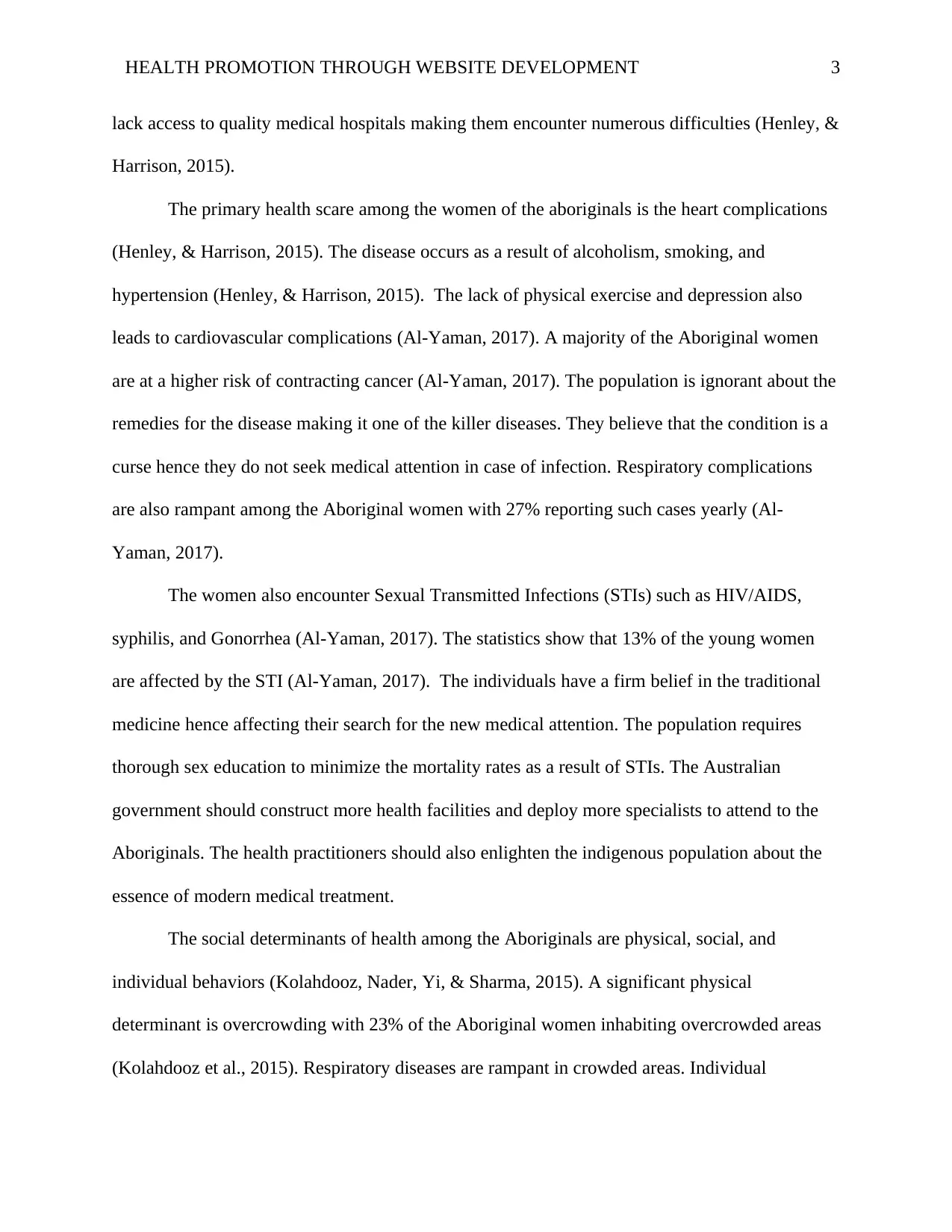
HEALTH PROMOTION THROUGH WEBSITE DEVELOPMENT 3
lack access to quality medical hospitals making them encounter numerous difficulties (Henley, &
Harrison, 2015).
The primary health scare among the women of the aboriginals is the heart complications
(Henley, & Harrison, 2015). The disease occurs as a result of alcoholism, smoking, and
hypertension (Henley, & Harrison, 2015). The lack of physical exercise and depression also
leads to cardiovascular complications (Al-Yaman, 2017). A majority of the Aboriginal women
are at a higher risk of contracting cancer (Al-Yaman, 2017). The population is ignorant about the
remedies for the disease making it one of the killer diseases. They believe that the condition is a
curse hence they do not seek medical attention in case of infection. Respiratory complications
are also rampant among the Aboriginal women with 27% reporting such cases yearly (Al-
Yaman, 2017).
The women also encounter Sexual Transmitted Infections (STIs) such as HIV/AIDS,
syphilis, and Gonorrhea (Al-Yaman, 2017). The statistics show that 13% of the young women
are affected by the STI (Al-Yaman, 2017). The individuals have a firm belief in the traditional
medicine hence affecting their search for the new medical attention. The population requires
thorough sex education to minimize the mortality rates as a result of STIs. The Australian
government should construct more health facilities and deploy more specialists to attend to the
Aboriginals. The health practitioners should also enlighten the indigenous population about the
essence of modern medical treatment.
The social determinants of health among the Aboriginals are physical, social, and
individual behaviors (Kolahdooz, Nader, Yi, & Sharma, 2015). A significant physical
determinant is overcrowding with 23% of the Aboriginal women inhabiting overcrowded areas
(Kolahdooz et al., 2015). Respiratory diseases are rampant in crowded areas. Individual
lack access to quality medical hospitals making them encounter numerous difficulties (Henley, &
Harrison, 2015).
The primary health scare among the women of the aboriginals is the heart complications
(Henley, & Harrison, 2015). The disease occurs as a result of alcoholism, smoking, and
hypertension (Henley, & Harrison, 2015). The lack of physical exercise and depression also
leads to cardiovascular complications (Al-Yaman, 2017). A majority of the Aboriginal women
are at a higher risk of contracting cancer (Al-Yaman, 2017). The population is ignorant about the
remedies for the disease making it one of the killer diseases. They believe that the condition is a
curse hence they do not seek medical attention in case of infection. Respiratory complications
are also rampant among the Aboriginal women with 27% reporting such cases yearly (Al-
Yaman, 2017).
The women also encounter Sexual Transmitted Infections (STIs) such as HIV/AIDS,
syphilis, and Gonorrhea (Al-Yaman, 2017). The statistics show that 13% of the young women
are affected by the STI (Al-Yaman, 2017). The individuals have a firm belief in the traditional
medicine hence affecting their search for the new medical attention. The population requires
thorough sex education to minimize the mortality rates as a result of STIs. The Australian
government should construct more health facilities and deploy more specialists to attend to the
Aboriginals. The health practitioners should also enlighten the indigenous population about the
essence of modern medical treatment.
The social determinants of health among the Aboriginals are physical, social, and
individual behaviors (Kolahdooz, Nader, Yi, & Sharma, 2015). A significant physical
determinant is overcrowding with 23% of the Aboriginal women inhabiting overcrowded areas
(Kolahdooz et al., 2015). Respiratory diseases are rampant in crowded areas. Individual
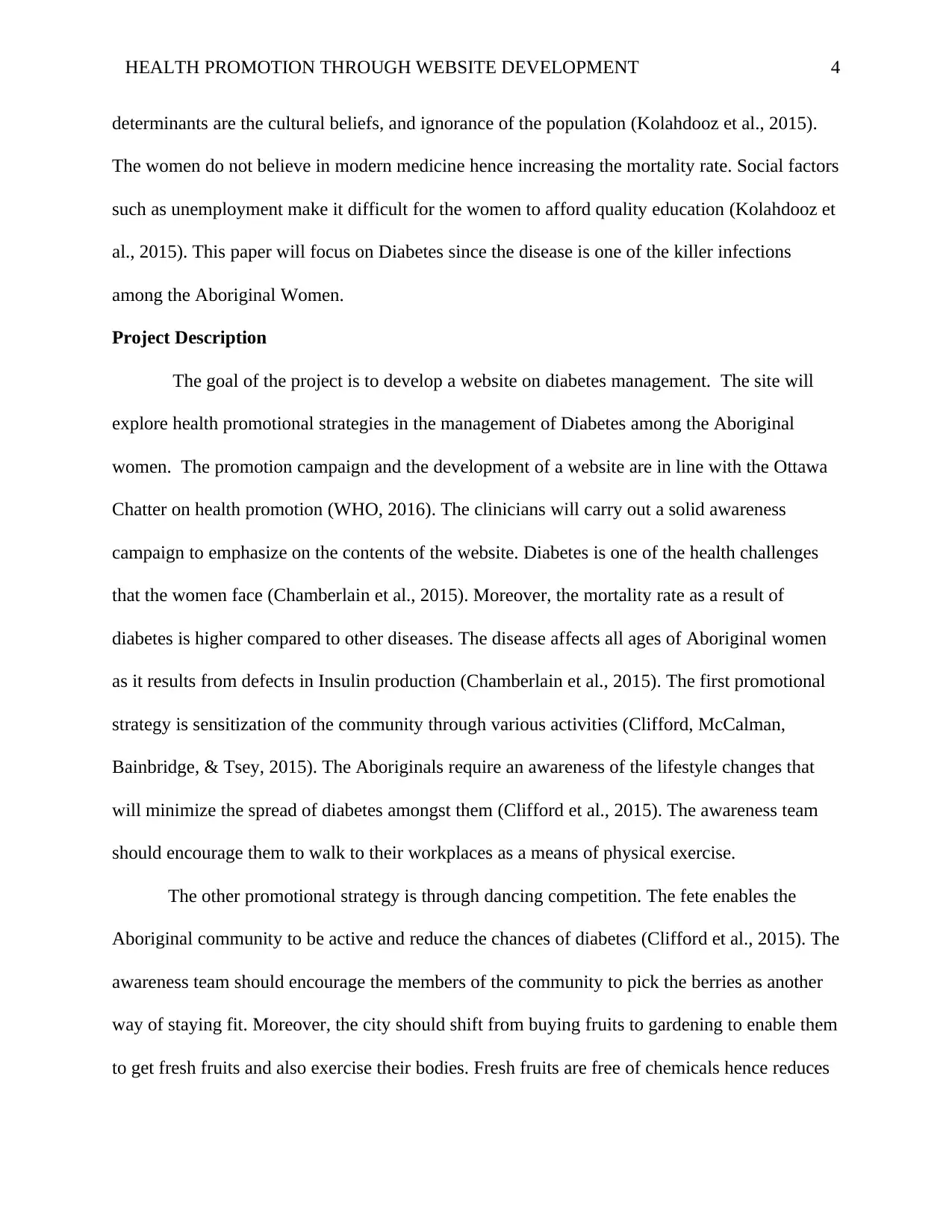
HEALTH PROMOTION THROUGH WEBSITE DEVELOPMENT 4
determinants are the cultural beliefs, and ignorance of the population (Kolahdooz et al., 2015).
The women do not believe in modern medicine hence increasing the mortality rate. Social factors
such as unemployment make it difficult for the women to afford quality education (Kolahdooz et
al., 2015). This paper will focus on Diabetes since the disease is one of the killer infections
among the Aboriginal Women.
Project Description
The goal of the project is to develop a website on diabetes management. The site will
explore health promotional strategies in the management of Diabetes among the Aboriginal
women. The promotion campaign and the development of a website are in line with the Ottawa
Chatter on health promotion (WHO, 2016). The clinicians will carry out a solid awareness
campaign to emphasize on the contents of the website. Diabetes is one of the health challenges
that the women face (Chamberlain et al., 2015). Moreover, the mortality rate as a result of
diabetes is higher compared to other diseases. The disease affects all ages of Aboriginal women
as it results from defects in Insulin production (Chamberlain et al., 2015). The first promotional
strategy is sensitization of the community through various activities (Clifford, McCalman,
Bainbridge, & Tsey, 2015). The Aboriginals require an awareness of the lifestyle changes that
will minimize the spread of diabetes amongst them (Clifford et al., 2015). The awareness team
should encourage them to walk to their workplaces as a means of physical exercise.
The other promotional strategy is through dancing competition. The fete enables the
Aboriginal community to be active and reduce the chances of diabetes (Clifford et al., 2015). The
awareness team should encourage the members of the community to pick the berries as another
way of staying fit. Moreover, the city should shift from buying fruits to gardening to enable them
to get fresh fruits and also exercise their bodies. Fresh fruits are free of chemicals hence reduces
determinants are the cultural beliefs, and ignorance of the population (Kolahdooz et al., 2015).
The women do not believe in modern medicine hence increasing the mortality rate. Social factors
such as unemployment make it difficult for the women to afford quality education (Kolahdooz et
al., 2015). This paper will focus on Diabetes since the disease is one of the killer infections
among the Aboriginal Women.
Project Description
The goal of the project is to develop a website on diabetes management. The site will
explore health promotional strategies in the management of Diabetes among the Aboriginal
women. The promotion campaign and the development of a website are in line with the Ottawa
Chatter on health promotion (WHO, 2016). The clinicians will carry out a solid awareness
campaign to emphasize on the contents of the website. Diabetes is one of the health challenges
that the women face (Chamberlain et al., 2015). Moreover, the mortality rate as a result of
diabetes is higher compared to other diseases. The disease affects all ages of Aboriginal women
as it results from defects in Insulin production (Chamberlain et al., 2015). The first promotional
strategy is sensitization of the community through various activities (Clifford, McCalman,
Bainbridge, & Tsey, 2015). The Aboriginals require an awareness of the lifestyle changes that
will minimize the spread of diabetes amongst them (Clifford et al., 2015). The awareness team
should encourage them to walk to their workplaces as a means of physical exercise.
The other promotional strategy is through dancing competition. The fete enables the
Aboriginal community to be active and reduce the chances of diabetes (Clifford et al., 2015). The
awareness team should encourage the members of the community to pick the berries as another
way of staying fit. Moreover, the city should shift from buying fruits to gardening to enable them
to get fresh fruits and also exercise their bodies. Fresh fruits are free of chemicals hence reduces
Secure Best Marks with AI Grader
Need help grading? Try our AI Grader for instant feedback on your assignments.
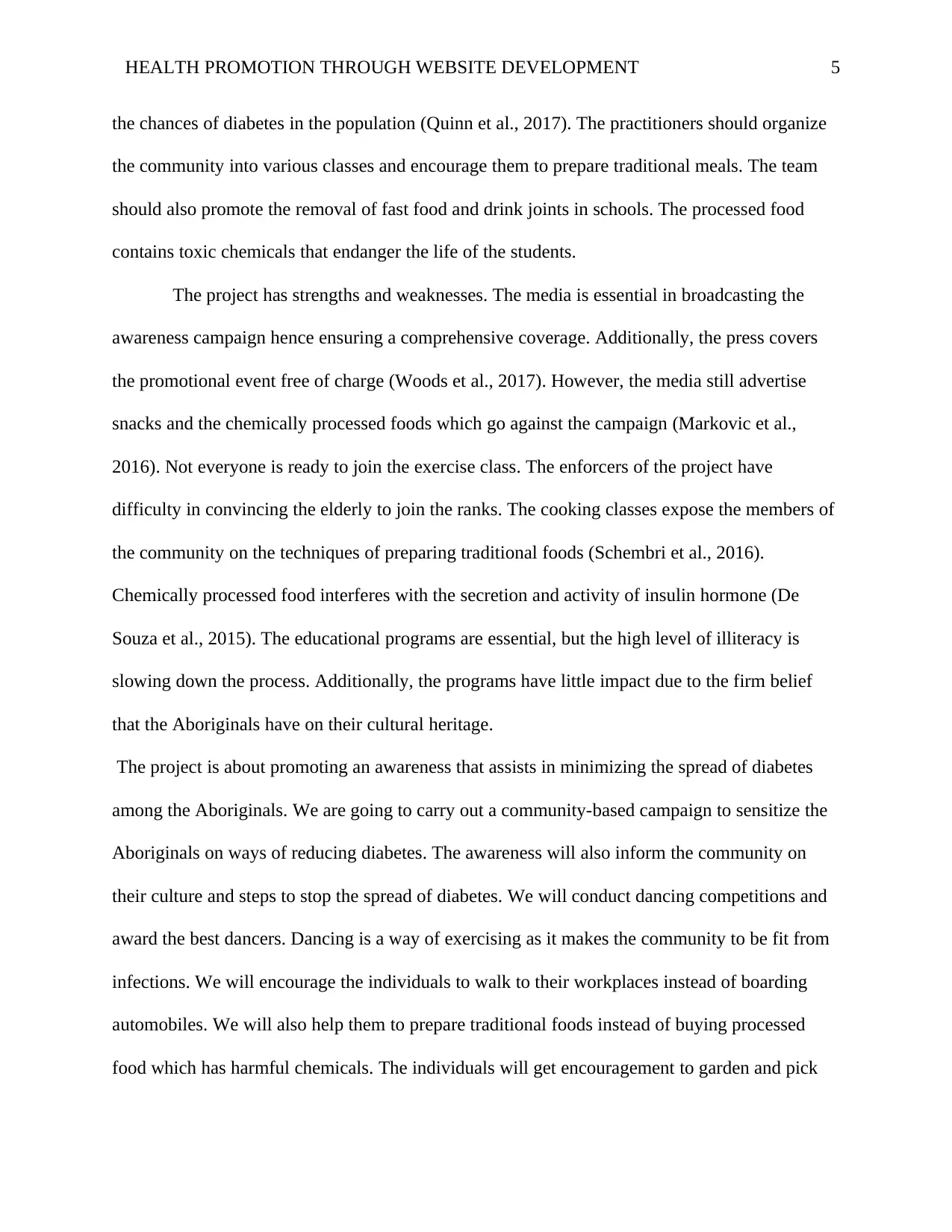
HEALTH PROMOTION THROUGH WEBSITE DEVELOPMENT 5
the chances of diabetes in the population (Quinn et al., 2017). The practitioners should organize
the community into various classes and encourage them to prepare traditional meals. The team
should also promote the removal of fast food and drink joints in schools. The processed food
contains toxic chemicals that endanger the life of the students.
The project has strengths and weaknesses. The media is essential in broadcasting the
awareness campaign hence ensuring a comprehensive coverage. Additionally, the press covers
the promotional event free of charge (Woods et al., 2017). However, the media still advertise
snacks and the chemically processed foods which go against the campaign (Markovic et al.,
2016). Not everyone is ready to join the exercise class. The enforcers of the project have
difficulty in convincing the elderly to join the ranks. The cooking classes expose the members of
the community on the techniques of preparing traditional foods (Schembri et al., 2016).
Chemically processed food interferes with the secretion and activity of insulin hormone (De
Souza et al., 2015). The educational programs are essential, but the high level of illiteracy is
slowing down the process. Additionally, the programs have little impact due to the firm belief
that the Aboriginals have on their cultural heritage.
The project is about promoting an awareness that assists in minimizing the spread of diabetes
among the Aboriginals. We are going to carry out a community-based campaign to sensitize the
Aboriginals on ways of reducing diabetes. The awareness will also inform the community on
their culture and steps to stop the spread of diabetes. We will conduct dancing competitions and
award the best dancers. Dancing is a way of exercising as it makes the community to be fit from
infections. We will encourage the individuals to walk to their workplaces instead of boarding
automobiles. We will also help them to prepare traditional foods instead of buying processed
food which has harmful chemicals. The individuals will get encouragement to garden and pick
the chances of diabetes in the population (Quinn et al., 2017). The practitioners should organize
the community into various classes and encourage them to prepare traditional meals. The team
should also promote the removal of fast food and drink joints in schools. The processed food
contains toxic chemicals that endanger the life of the students.
The project has strengths and weaknesses. The media is essential in broadcasting the
awareness campaign hence ensuring a comprehensive coverage. Additionally, the press covers
the promotional event free of charge (Woods et al., 2017). However, the media still advertise
snacks and the chemically processed foods which go against the campaign (Markovic et al.,
2016). Not everyone is ready to join the exercise class. The enforcers of the project have
difficulty in convincing the elderly to join the ranks. The cooking classes expose the members of
the community on the techniques of preparing traditional foods (Schembri et al., 2016).
Chemically processed food interferes with the secretion and activity of insulin hormone (De
Souza et al., 2015). The educational programs are essential, but the high level of illiteracy is
slowing down the process. Additionally, the programs have little impact due to the firm belief
that the Aboriginals have on their cultural heritage.
The project is about promoting an awareness that assists in minimizing the spread of diabetes
among the Aboriginals. We are going to carry out a community-based campaign to sensitize the
Aboriginals on ways of reducing diabetes. The awareness will also inform the community on
their culture and steps to stop the spread of diabetes. We will conduct dancing competitions and
award the best dancers. Dancing is a way of exercising as it makes the community to be fit from
infections. We will encourage the individuals to walk to their workplaces instead of boarding
automobiles. We will also help them to prepare traditional foods instead of buying processed
food which has harmful chemicals. The individuals will get encouragement to garden and pick
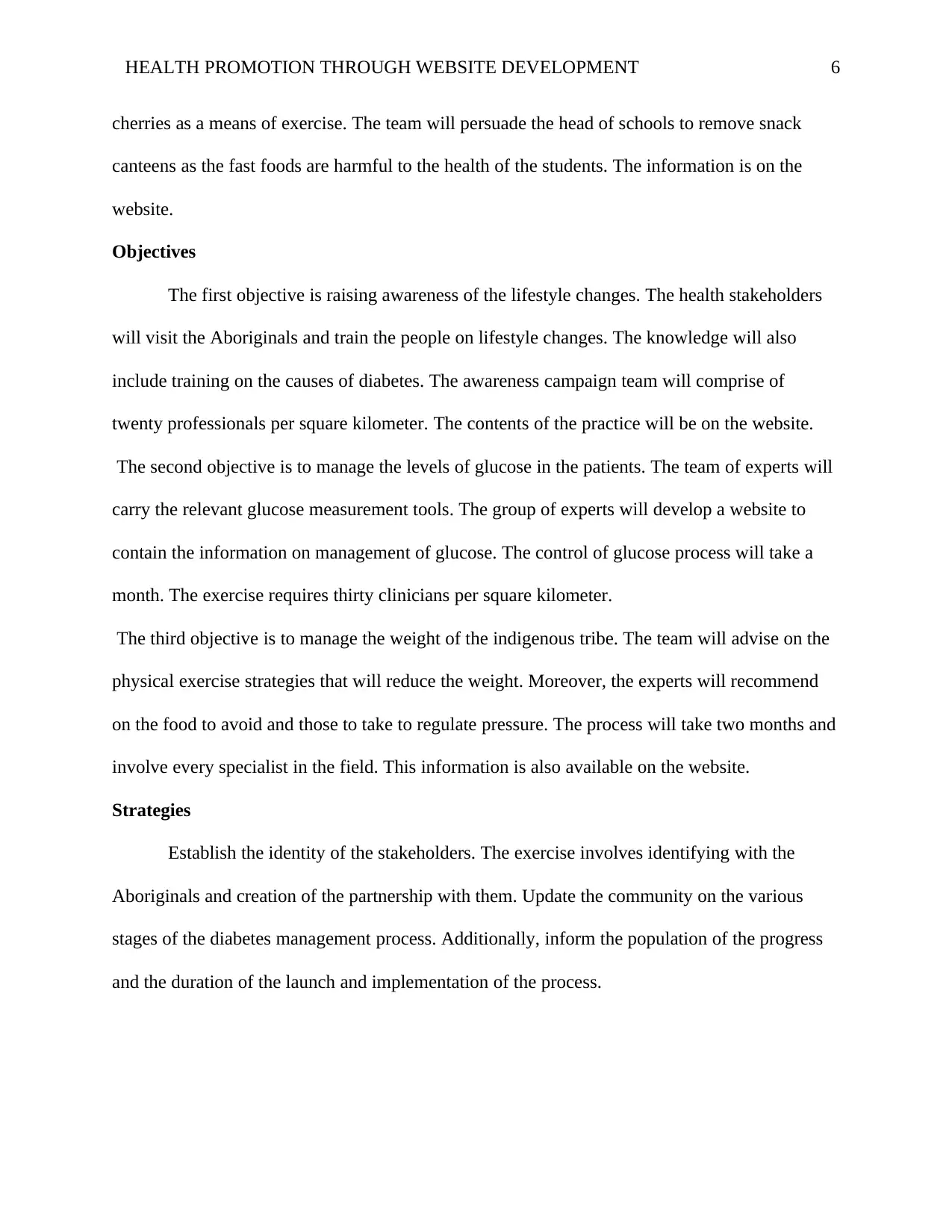
HEALTH PROMOTION THROUGH WEBSITE DEVELOPMENT 6
cherries as a means of exercise. The team will persuade the head of schools to remove snack
canteens as the fast foods are harmful to the health of the students. The information is on the
website.
Objectives
The first objective is raising awareness of the lifestyle changes. The health stakeholders
will visit the Aboriginals and train the people on lifestyle changes. The knowledge will also
include training on the causes of diabetes. The awareness campaign team will comprise of
twenty professionals per square kilometer. The contents of the practice will be on the website.
The second objective is to manage the levels of glucose in the patients. The team of experts will
carry the relevant glucose measurement tools. The group of experts will develop a website to
contain the information on management of glucose. The control of glucose process will take a
month. The exercise requires thirty clinicians per square kilometer.
The third objective is to manage the weight of the indigenous tribe. The team will advise on the
physical exercise strategies that will reduce the weight. Moreover, the experts will recommend
on the food to avoid and those to take to regulate pressure. The process will take two months and
involve every specialist in the field. This information is also available on the website.
Strategies
Establish the identity of the stakeholders. The exercise involves identifying with the
Aboriginals and creation of the partnership with them. Update the community on the various
stages of the diabetes management process. Additionally, inform the population of the progress
and the duration of the launch and implementation of the process.
cherries as a means of exercise. The team will persuade the head of schools to remove snack
canteens as the fast foods are harmful to the health of the students. The information is on the
website.
Objectives
The first objective is raising awareness of the lifestyle changes. The health stakeholders
will visit the Aboriginals and train the people on lifestyle changes. The knowledge will also
include training on the causes of diabetes. The awareness campaign team will comprise of
twenty professionals per square kilometer. The contents of the practice will be on the website.
The second objective is to manage the levels of glucose in the patients. The team of experts will
carry the relevant glucose measurement tools. The group of experts will develop a website to
contain the information on management of glucose. The control of glucose process will take a
month. The exercise requires thirty clinicians per square kilometer.
The third objective is to manage the weight of the indigenous tribe. The team will advise on the
physical exercise strategies that will reduce the weight. Moreover, the experts will recommend
on the food to avoid and those to take to regulate pressure. The process will take two months and
involve every specialist in the field. This information is also available on the website.
Strategies
Establish the identity of the stakeholders. The exercise involves identifying with the
Aboriginals and creation of the partnership with them. Update the community on the various
stages of the diabetes management process. Additionally, inform the population of the progress
and the duration of the launch and implementation of the process.
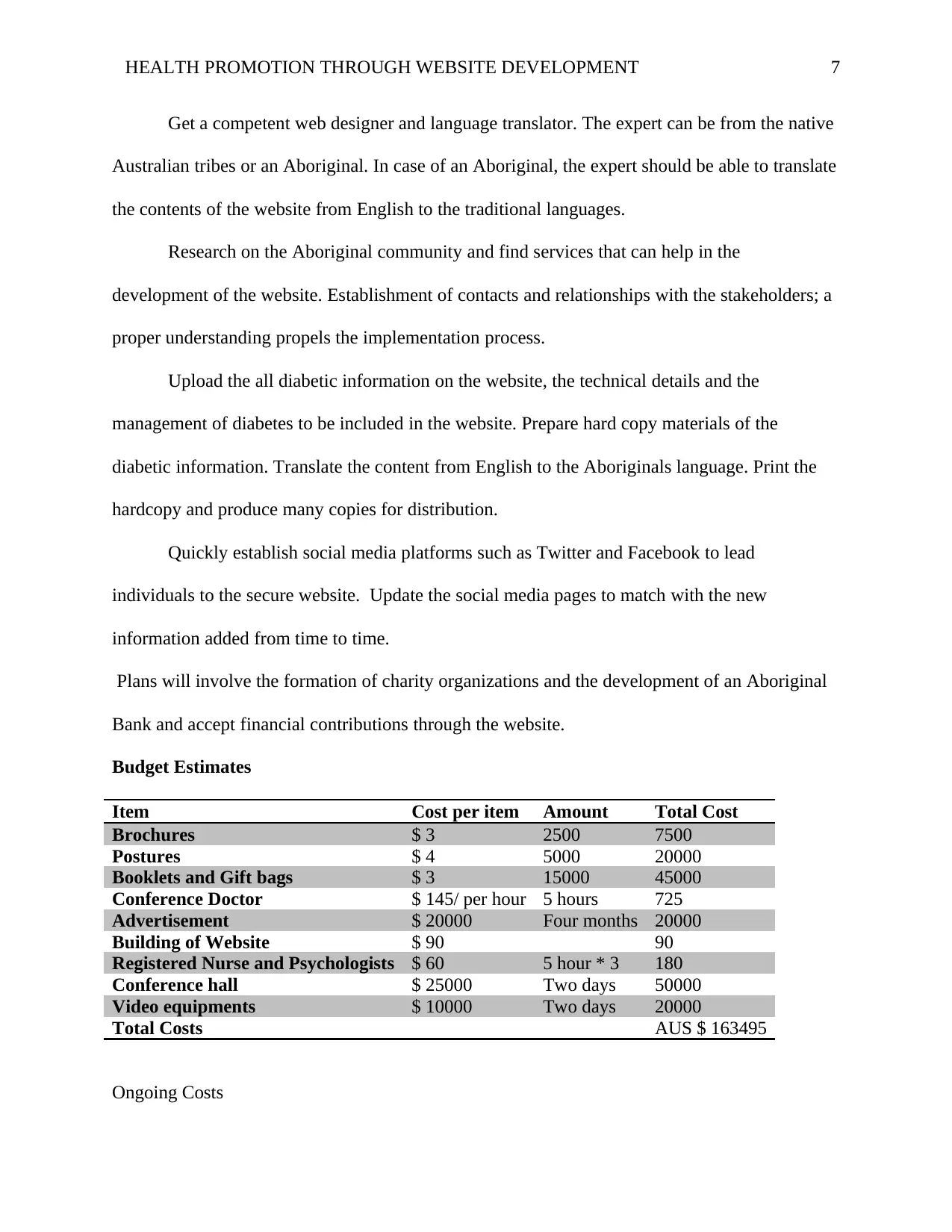
HEALTH PROMOTION THROUGH WEBSITE DEVELOPMENT 7
Get a competent web designer and language translator. The expert can be from the native
Australian tribes or an Aboriginal. In case of an Aboriginal, the expert should be able to translate
the contents of the website from English to the traditional languages.
Research on the Aboriginal community and find services that can help in the
development of the website. Establishment of contacts and relationships with the stakeholders; a
proper understanding propels the implementation process.
Upload the all diabetic information on the website, the technical details and the
management of diabetes to be included in the website. Prepare hard copy materials of the
diabetic information. Translate the content from English to the Aboriginals language. Print the
hardcopy and produce many copies for distribution.
Quickly establish social media platforms such as Twitter and Facebook to lead
individuals to the secure website. Update the social media pages to match with the new
information added from time to time.
Plans will involve the formation of charity organizations and the development of an Aboriginal
Bank and accept financial contributions through the website.
Budget Estimates
Item Cost per item Amount Total Cost
Brochures $ 3 2500 7500
Postures $ 4 5000 20000
Booklets and Gift bags $ 3 15000 45000
Conference Doctor $ 145/ per hour 5 hours 725
Advertisement $ 20000 Four months 20000
Building of Website $ 90 90
Registered Nurse and Psychologists $ 60 5 hour * 3 180
Conference hall $ 25000 Two days 50000
Video equipments $ 10000 Two days 20000
Total Costs AUS $ 163495
Ongoing Costs
Get a competent web designer and language translator. The expert can be from the native
Australian tribes or an Aboriginal. In case of an Aboriginal, the expert should be able to translate
the contents of the website from English to the traditional languages.
Research on the Aboriginal community and find services that can help in the
development of the website. Establishment of contacts and relationships with the stakeholders; a
proper understanding propels the implementation process.
Upload the all diabetic information on the website, the technical details and the
management of diabetes to be included in the website. Prepare hard copy materials of the
diabetic information. Translate the content from English to the Aboriginals language. Print the
hardcopy and produce many copies for distribution.
Quickly establish social media platforms such as Twitter and Facebook to lead
individuals to the secure website. Update the social media pages to match with the new
information added from time to time.
Plans will involve the formation of charity organizations and the development of an Aboriginal
Bank and accept financial contributions through the website.
Budget Estimates
Item Cost per item Amount Total Cost
Brochures $ 3 2500 7500
Postures $ 4 5000 20000
Booklets and Gift bags $ 3 15000 45000
Conference Doctor $ 145/ per hour 5 hours 725
Advertisement $ 20000 Four months 20000
Building of Website $ 90 90
Registered Nurse and Psychologists $ 60 5 hour * 3 180
Conference hall $ 25000 Two days 50000
Video equipments $ 10000 Two days 20000
Total Costs AUS $ 163495
Ongoing Costs
Paraphrase This Document
Need a fresh take? Get an instant paraphrase of this document with our AI Paraphraser
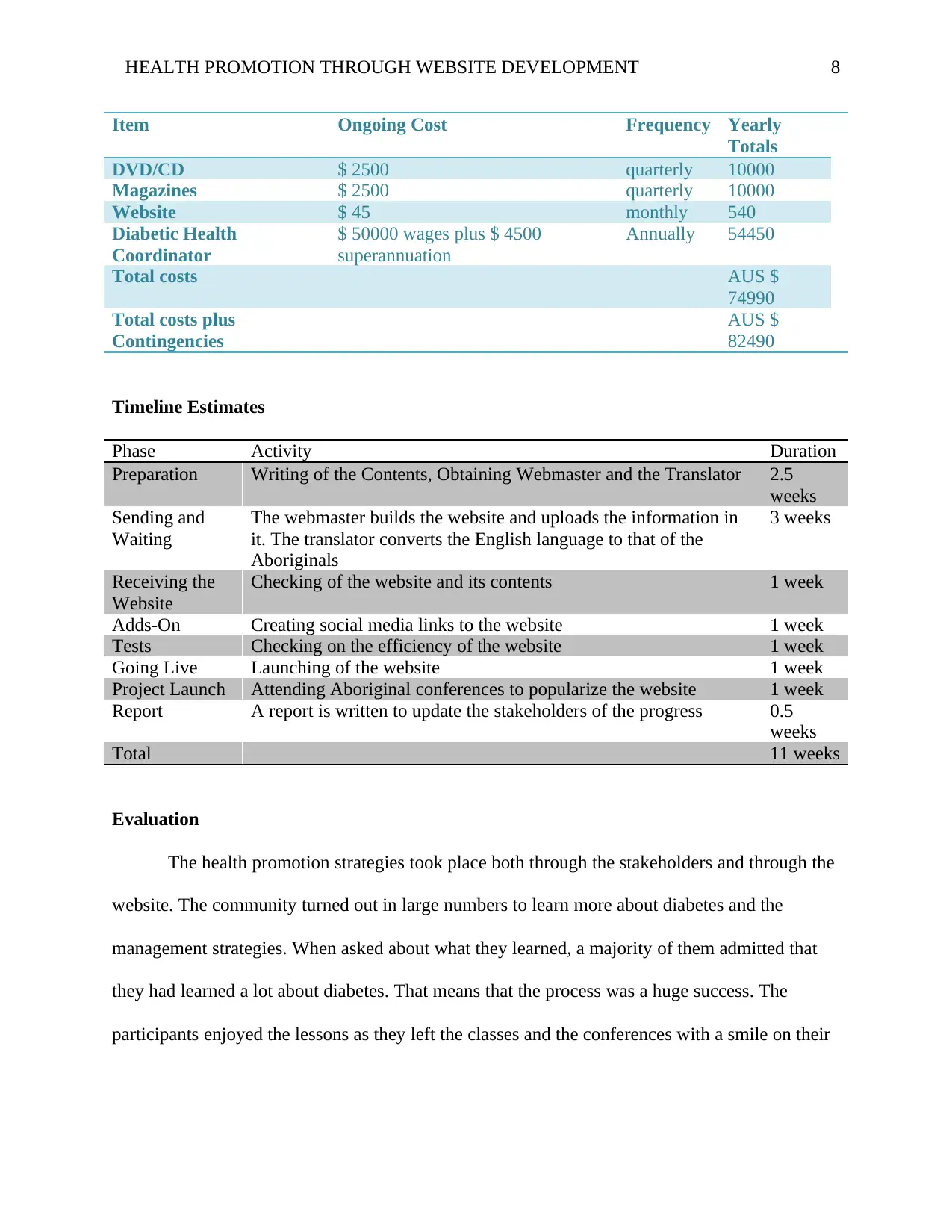
HEALTH PROMOTION THROUGH WEBSITE DEVELOPMENT 8
Item Ongoing Cost Frequency Yearly
Totals
DVD/CD $ 2500 quarterly 10000
Magazines $ 2500 quarterly 10000
Website $ 45 monthly 540
Diabetic Health
Coordinator
$ 50000 wages plus $ 4500
superannuation
Annually 54450
Total costs AUS $
74990
Total costs plus
Contingencies
AUS $
82490
Timeline Estimates
Phase Activity Duration
Preparation Writing of the Contents, Obtaining Webmaster and the Translator 2.5
weeks
Sending and
Waiting
The webmaster builds the website and uploads the information in
it. The translator converts the English language to that of the
Aboriginals
3 weeks
Receiving the
Website
Checking of the website and its contents 1 week
Adds-On Creating social media links to the website 1 week
Tests Checking on the efficiency of the website 1 week
Going Live Launching of the website 1 week
Project Launch Attending Aboriginal conferences to popularize the website 1 week
Report A report is written to update the stakeholders of the progress 0.5
weeks
Total 11 weeks
Evaluation
The health promotion strategies took place both through the stakeholders and through the
website. The community turned out in large numbers to learn more about diabetes and the
management strategies. When asked about what they learned, a majority of them admitted that
they had learned a lot about diabetes. That means that the process was a huge success. The
participants enjoyed the lessons as they left the classes and the conferences with a smile on their
Item Ongoing Cost Frequency Yearly
Totals
DVD/CD $ 2500 quarterly 10000
Magazines $ 2500 quarterly 10000
Website $ 45 monthly 540
Diabetic Health
Coordinator
$ 50000 wages plus $ 4500
superannuation
Annually 54450
Total costs AUS $
74990
Total costs plus
Contingencies
AUS $
82490
Timeline Estimates
Phase Activity Duration
Preparation Writing of the Contents, Obtaining Webmaster and the Translator 2.5
weeks
Sending and
Waiting
The webmaster builds the website and uploads the information in
it. The translator converts the English language to that of the
Aboriginals
3 weeks
Receiving the
Website
Checking of the website and its contents 1 week
Adds-On Creating social media links to the website 1 week
Tests Checking on the efficiency of the website 1 week
Going Live Launching of the website 1 week
Project Launch Attending Aboriginal conferences to popularize the website 1 week
Report A report is written to update the stakeholders of the progress 0.5
weeks
Total 11 weeks
Evaluation
The health promotion strategies took place both through the stakeholders and through the
website. The community turned out in large numbers to learn more about diabetes and the
management strategies. When asked about what they learned, a majority of them admitted that
they had learned a lot about diabetes. That means that the process was a huge success. The
participants enjoyed the lessons as they left the classes and the conferences with a smile on their
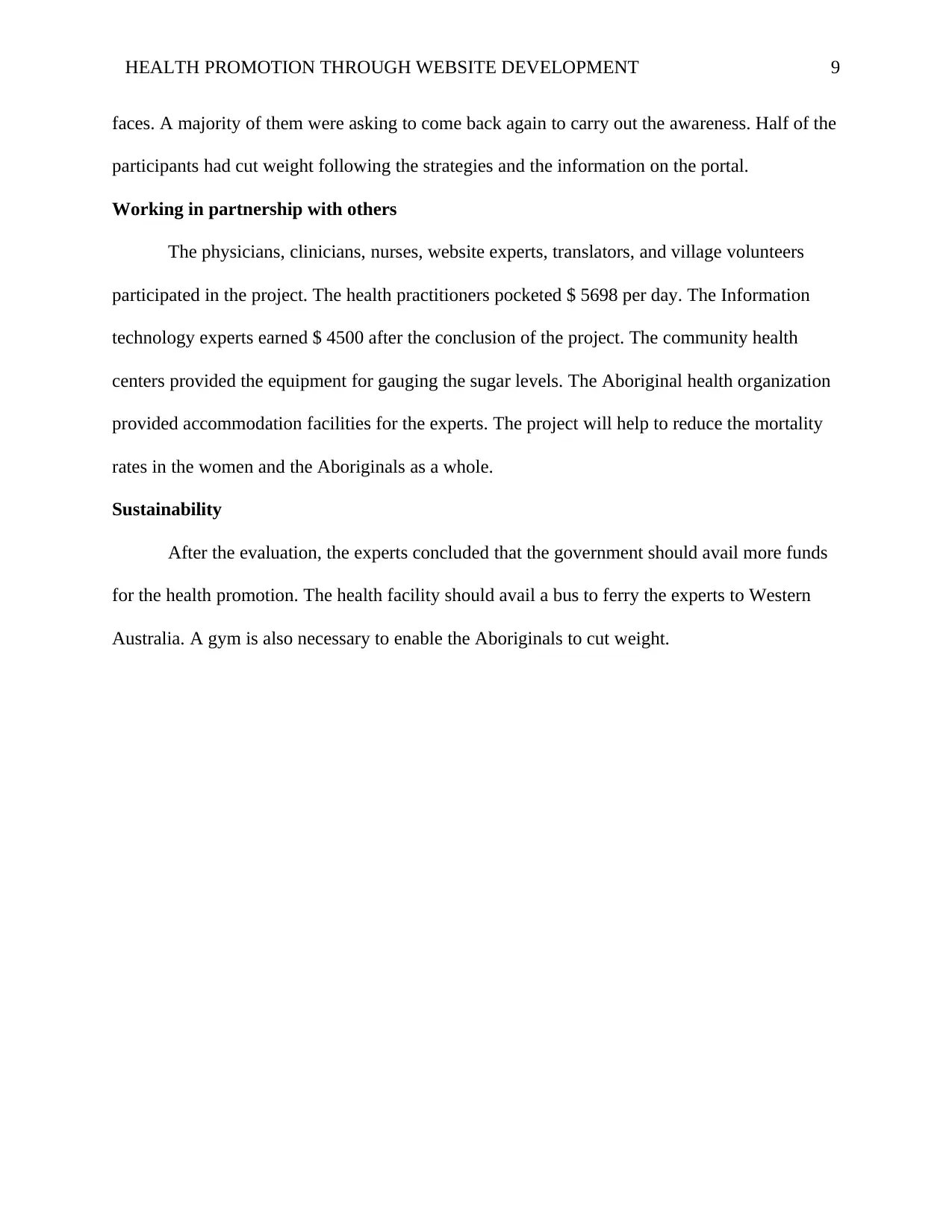
HEALTH PROMOTION THROUGH WEBSITE DEVELOPMENT 9
faces. A majority of them were asking to come back again to carry out the awareness. Half of the
participants had cut weight following the strategies and the information on the portal.
Working in partnership with others
The physicians, clinicians, nurses, website experts, translators, and village volunteers
participated in the project. The health practitioners pocketed $ 5698 per day. The Information
technology experts earned $ 4500 after the conclusion of the project. The community health
centers provided the equipment for gauging the sugar levels. The Aboriginal health organization
provided accommodation facilities for the experts. The project will help to reduce the mortality
rates in the women and the Aboriginals as a whole.
Sustainability
After the evaluation, the experts concluded that the government should avail more funds
for the health promotion. The health facility should avail a bus to ferry the experts to Western
Australia. A gym is also necessary to enable the Aboriginals to cut weight.
faces. A majority of them were asking to come back again to carry out the awareness. Half of the
participants had cut weight following the strategies and the information on the portal.
Working in partnership with others
The physicians, clinicians, nurses, website experts, translators, and village volunteers
participated in the project. The health practitioners pocketed $ 5698 per day. The Information
technology experts earned $ 4500 after the conclusion of the project. The community health
centers provided the equipment for gauging the sugar levels. The Aboriginal health organization
provided accommodation facilities for the experts. The project will help to reduce the mortality
rates in the women and the Aboriginals as a whole.
Sustainability
After the evaluation, the experts concluded that the government should avail more funds
for the health promotion. The health facility should avail a bus to ferry the experts to Western
Australia. A gym is also necessary to enable the Aboriginals to cut weight.
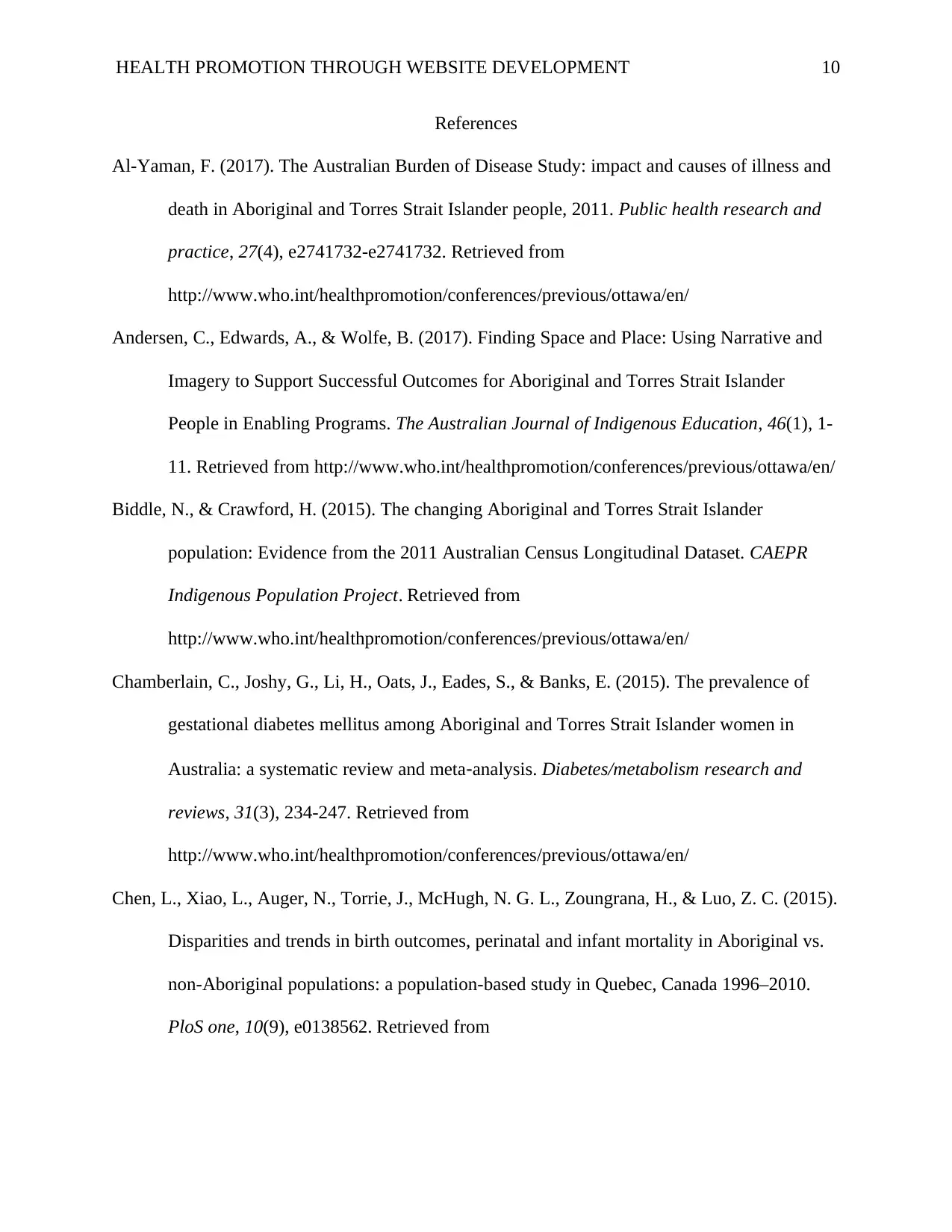
HEALTH PROMOTION THROUGH WEBSITE DEVELOPMENT 10
References
Al-Yaman, F. (2017). The Australian Burden of Disease Study: impact and causes of illness and
death in Aboriginal and Torres Strait Islander people, 2011. Public health research and
practice, 27(4), e2741732-e2741732. Retrieved from
http://www.who.int/healthpromotion/conferences/previous/ottawa/en/
Andersen, C., Edwards, A., & Wolfe, B. (2017). Finding Space and Place: Using Narrative and
Imagery to Support Successful Outcomes for Aboriginal and Torres Strait Islander
People in Enabling Programs. The Australian Journal of Indigenous Education, 46(1), 1-
11. Retrieved from http://www.who.int/healthpromotion/conferences/previous/ottawa/en/
Biddle, N., & Crawford, H. (2015). The changing Aboriginal and Torres Strait Islander
population: Evidence from the 2011 Australian Census Longitudinal Dataset. CAEPR
Indigenous Population Project. Retrieved from
http://www.who.int/healthpromotion/conferences/previous/ottawa/en/
Chamberlain, C., Joshy, G., Li, H., Oats, J., Eades, S., & Banks, E. (2015). The prevalence of
gestational diabetes mellitus among Aboriginal and Torres Strait Islander women in
Australia: a systematic review and meta‐analysis. Diabetes/metabolism research and
reviews, 31(3), 234-247. Retrieved from
http://www.who.int/healthpromotion/conferences/previous/ottawa/en/
Chen, L., Xiao, L., Auger, N., Torrie, J., McHugh, N. G. L., Zoungrana, H., & Luo, Z. C. (2015).
Disparities and trends in birth outcomes, perinatal and infant mortality in Aboriginal vs.
non-Aboriginal populations: a population-based study in Quebec, Canada 1996–2010.
PloS one, 10(9), e0138562. Retrieved from
References
Al-Yaman, F. (2017). The Australian Burden of Disease Study: impact and causes of illness and
death in Aboriginal and Torres Strait Islander people, 2011. Public health research and
practice, 27(4), e2741732-e2741732. Retrieved from
http://www.who.int/healthpromotion/conferences/previous/ottawa/en/
Andersen, C., Edwards, A., & Wolfe, B. (2017). Finding Space and Place: Using Narrative and
Imagery to Support Successful Outcomes for Aboriginal and Torres Strait Islander
People in Enabling Programs. The Australian Journal of Indigenous Education, 46(1), 1-
11. Retrieved from http://www.who.int/healthpromotion/conferences/previous/ottawa/en/
Biddle, N., & Crawford, H. (2015). The changing Aboriginal and Torres Strait Islander
population: Evidence from the 2011 Australian Census Longitudinal Dataset. CAEPR
Indigenous Population Project. Retrieved from
http://www.who.int/healthpromotion/conferences/previous/ottawa/en/
Chamberlain, C., Joshy, G., Li, H., Oats, J., Eades, S., & Banks, E. (2015). The prevalence of
gestational diabetes mellitus among Aboriginal and Torres Strait Islander women in
Australia: a systematic review and meta‐analysis. Diabetes/metabolism research and
reviews, 31(3), 234-247. Retrieved from
http://www.who.int/healthpromotion/conferences/previous/ottawa/en/
Chen, L., Xiao, L., Auger, N., Torrie, J., McHugh, N. G. L., Zoungrana, H., & Luo, Z. C. (2015).
Disparities and trends in birth outcomes, perinatal and infant mortality in Aboriginal vs.
non-Aboriginal populations: a population-based study in Quebec, Canada 1996–2010.
PloS one, 10(9), e0138562. Retrieved from
Secure Best Marks with AI Grader
Need help grading? Try our AI Grader for instant feedback on your assignments.
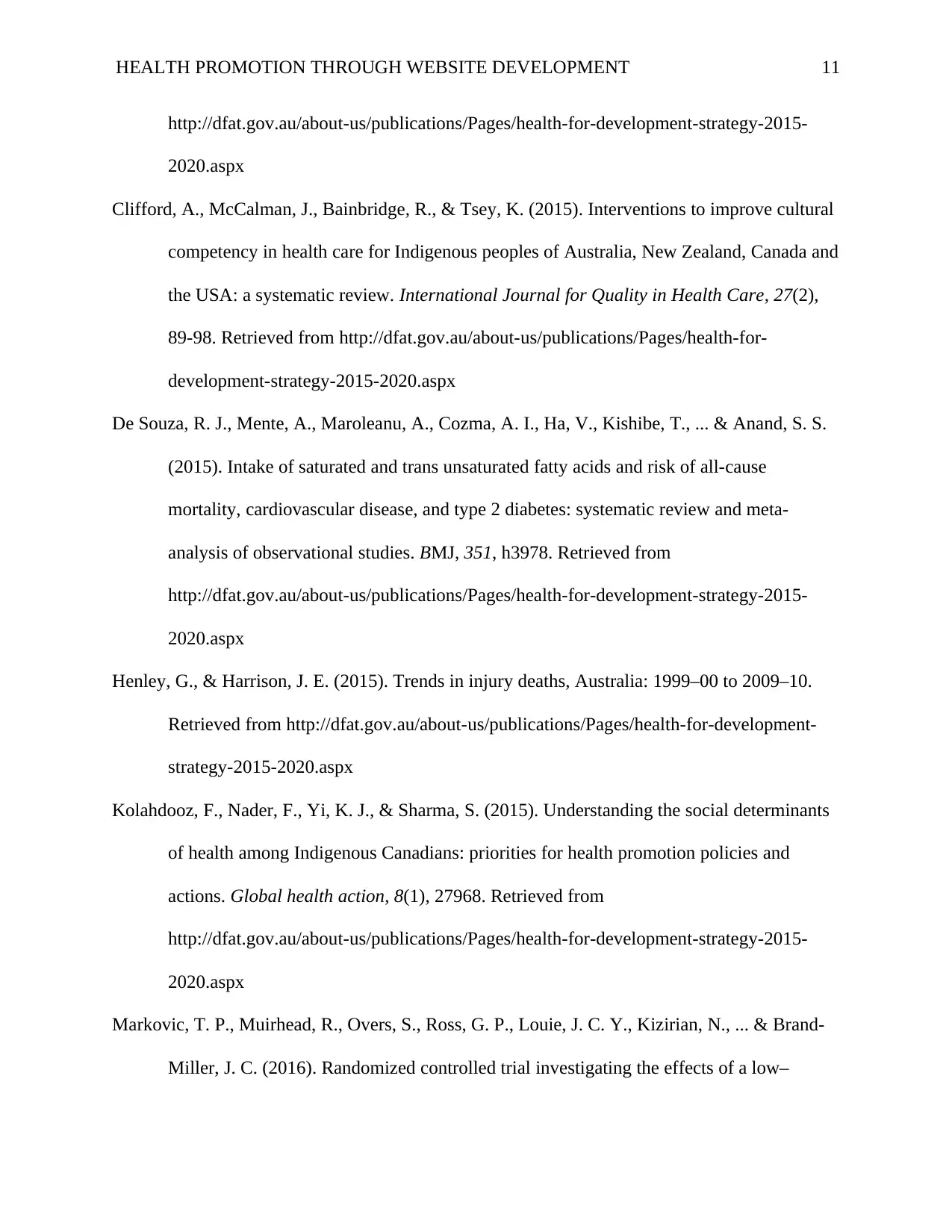
HEALTH PROMOTION THROUGH WEBSITE DEVELOPMENT 11
http://dfat.gov.au/about-us/publications/Pages/health-for-development-strategy-2015-
2020.aspx
Clifford, A., McCalman, J., Bainbridge, R., & Tsey, K. (2015). Interventions to improve cultural
competency in health care for Indigenous peoples of Australia, New Zealand, Canada and
the USA: a systematic review. International Journal for Quality in Health Care, 27(2),
89-98. Retrieved from http://dfat.gov.au/about-us/publications/Pages/health-for-
development-strategy-2015-2020.aspx
De Souza, R. J., Mente, A., Maroleanu, A., Cozma, A. I., Ha, V., Kishibe, T., ... & Anand, S. S.
(2015). Intake of saturated and trans unsaturated fatty acids and risk of all-cause
mortality, cardiovascular disease, and type 2 diabetes: systematic review and meta-
analysis of observational studies. BMJ, 351, h3978. Retrieved from
http://dfat.gov.au/about-us/publications/Pages/health-for-development-strategy-2015-
2020.aspx
Henley, G., & Harrison, J. E. (2015). Trends in injury deaths, Australia: 1999–00 to 2009–10.
Retrieved from http://dfat.gov.au/about-us/publications/Pages/health-for-development-
strategy-2015-2020.aspx
Kolahdooz, F., Nader, F., Yi, K. J., & Sharma, S. (2015). Understanding the social determinants
of health among Indigenous Canadians: priorities for health promotion policies and
actions. Global health action, 8(1), 27968. Retrieved from
http://dfat.gov.au/about-us/publications/Pages/health-for-development-strategy-2015-
2020.aspx
Markovic, T. P., Muirhead, R., Overs, S., Ross, G. P., Louie, J. C. Y., Kizirian, N., ... & Brand-
Miller, J. C. (2016). Randomized controlled trial investigating the effects of a low–
http://dfat.gov.au/about-us/publications/Pages/health-for-development-strategy-2015-
2020.aspx
Clifford, A., McCalman, J., Bainbridge, R., & Tsey, K. (2015). Interventions to improve cultural
competency in health care for Indigenous peoples of Australia, New Zealand, Canada and
the USA: a systematic review. International Journal for Quality in Health Care, 27(2),
89-98. Retrieved from http://dfat.gov.au/about-us/publications/Pages/health-for-
development-strategy-2015-2020.aspx
De Souza, R. J., Mente, A., Maroleanu, A., Cozma, A. I., Ha, V., Kishibe, T., ... & Anand, S. S.
(2015). Intake of saturated and trans unsaturated fatty acids and risk of all-cause
mortality, cardiovascular disease, and type 2 diabetes: systematic review and meta-
analysis of observational studies. BMJ, 351, h3978. Retrieved from
http://dfat.gov.au/about-us/publications/Pages/health-for-development-strategy-2015-
2020.aspx
Henley, G., & Harrison, J. E. (2015). Trends in injury deaths, Australia: 1999–00 to 2009–10.
Retrieved from http://dfat.gov.au/about-us/publications/Pages/health-for-development-
strategy-2015-2020.aspx
Kolahdooz, F., Nader, F., Yi, K. J., & Sharma, S. (2015). Understanding the social determinants
of health among Indigenous Canadians: priorities for health promotion policies and
actions. Global health action, 8(1), 27968. Retrieved from
http://dfat.gov.au/about-us/publications/Pages/health-for-development-strategy-2015-
2020.aspx
Markovic, T. P., Muirhead, R., Overs, S., Ross, G. P., Louie, J. C. Y., Kizirian, N., ... & Brand-
Miller, J. C. (2016). Randomized controlled trial investigating the effects of a low–

HEALTH PROMOTION THROUGH WEBSITE DEVELOPMENT 12
glycemic index diet on pregnancy outcomes in women at high risk of gestational diabetes
mellitus: the GI Baby 3 Study. Diabetes Care, 39(1), 31-38. Retrieved from
https://www.australia.gov.au/information-and-services/health/health-promotion
Phillips, B., Morrell, S., Taylor, R., & Daniels, J. (2014). A review of life expectancy and infant
mortality estimations for Australian Aboriginal people. BMC Public Health, 14(1), 1. .
Retrieved from https://www.australia.gov.au/information-and-services/health/health-
promotion
Quinn, E., O’Hara, B. J., Ahmed, N., Winch, S., McGill, B., Banovic, D., ... & Rissel, C. (2017).
Enhancing the get healthy information and coaching service for Aboriginal adults:
evaluation of the process and impact of the program. International journal for equity in
health, 16(1), 168. . Retrieved from https://www.australia.gov.au/information-and-
services/health/health-promotion
Schembri, L., Curran, J., Collins, L., Pelinovskaia, M., Bell, H., Richardson, C., & Palermo, C.
(2016). The effect of nutrition education on nutrition‐related health outcomes of
Aboriginal and Torres Strait Islander people: a systematic review. Australian and New
Zealand journal of public health, 40(S1). . Retrieved from
https://www.australia.gov.au/information-and-services/health/health-promotion
Wallis, B. A., Watt, K., Franklin, R. C., Nixon, J. W., & Kimble, R. M. (2015). Drowning
mortality and morbidity rates in children and adolescents 0-19yrs: a population-based
study in Queensland, Australia. PLoS One, 10(2), e0117948 . Retrieved from
https://www.australia.gov.au/information-and-services/health/health-promotion
Woods, C., Carlisle, K., Larkins, S., Thompson, S. C., Tsey, K., Matthews, V., & Bailie, R.
(2017). Exploring Systems That Support Good Clinical Care in Indigenous Primary
glycemic index diet on pregnancy outcomes in women at high risk of gestational diabetes
mellitus: the GI Baby 3 Study. Diabetes Care, 39(1), 31-38. Retrieved from
https://www.australia.gov.au/information-and-services/health/health-promotion
Phillips, B., Morrell, S., Taylor, R., & Daniels, J. (2014). A review of life expectancy and infant
mortality estimations for Australian Aboriginal people. BMC Public Health, 14(1), 1. .
Retrieved from https://www.australia.gov.au/information-and-services/health/health-
promotion
Quinn, E., O’Hara, B. J., Ahmed, N., Winch, S., McGill, B., Banovic, D., ... & Rissel, C. (2017).
Enhancing the get healthy information and coaching service for Aboriginal adults:
evaluation of the process and impact of the program. International journal for equity in
health, 16(1), 168. . Retrieved from https://www.australia.gov.au/information-and-
services/health/health-promotion
Schembri, L., Curran, J., Collins, L., Pelinovskaia, M., Bell, H., Richardson, C., & Palermo, C.
(2016). The effect of nutrition education on nutrition‐related health outcomes of
Aboriginal and Torres Strait Islander people: a systematic review. Australian and New
Zealand journal of public health, 40(S1). . Retrieved from
https://www.australia.gov.au/information-and-services/health/health-promotion
Wallis, B. A., Watt, K., Franklin, R. C., Nixon, J. W., & Kimble, R. M. (2015). Drowning
mortality and morbidity rates in children and adolescents 0-19yrs: a population-based
study in Queensland, Australia. PLoS One, 10(2), e0117948 . Retrieved from
https://www.australia.gov.au/information-and-services/health/health-promotion
Woods, C., Carlisle, K., Larkins, S., Thompson, S. C., Tsey, K., Matthews, V., & Bailie, R.
(2017). Exploring Systems That Support Good Clinical Care in Indigenous Primary
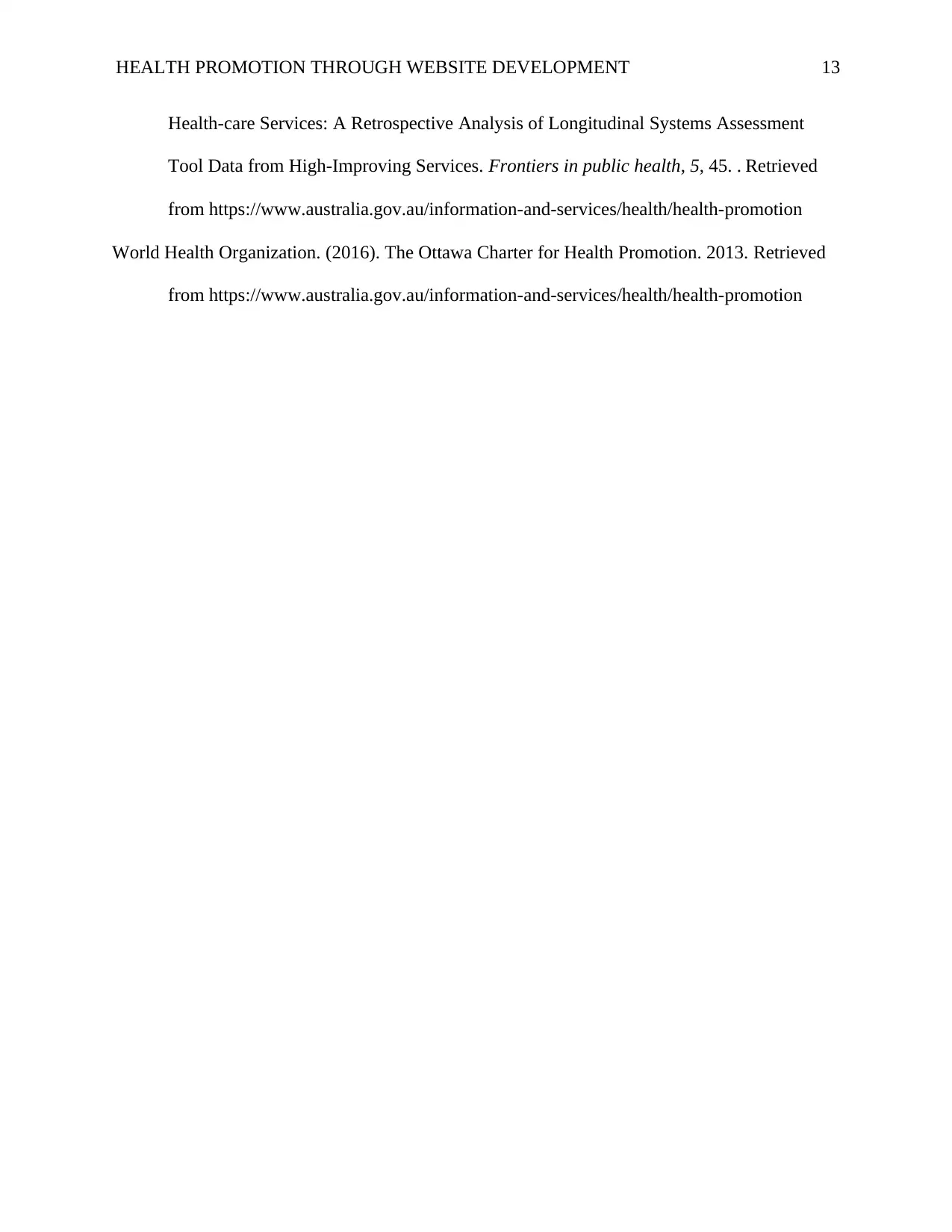
HEALTH PROMOTION THROUGH WEBSITE DEVELOPMENT 13
Health-care Services: A Retrospective Analysis of Longitudinal Systems Assessment
Tool Data from High-Improving Services. Frontiers in public health, 5, 45. . Retrieved
from https://www.australia.gov.au/information-and-services/health/health-promotion
World Health Organization. (2016). The Ottawa Charter for Health Promotion. 2013. Retrieved
from https://www.australia.gov.au/information-and-services/health/health-promotion
Health-care Services: A Retrospective Analysis of Longitudinal Systems Assessment
Tool Data from High-Improving Services. Frontiers in public health, 5, 45. . Retrieved
from https://www.australia.gov.au/information-and-services/health/health-promotion
World Health Organization. (2016). The Ottawa Charter for Health Promotion. 2013. Retrieved
from https://www.australia.gov.au/information-and-services/health/health-promotion
1 out of 13
Related Documents
Your All-in-One AI-Powered Toolkit for Academic Success.
+13062052269
info@desklib.com
Available 24*7 on WhatsApp / Email
![[object Object]](/_next/static/media/star-bottom.7253800d.svg)
Unlock your academic potential
© 2024 | Zucol Services PVT LTD | All rights reserved.





